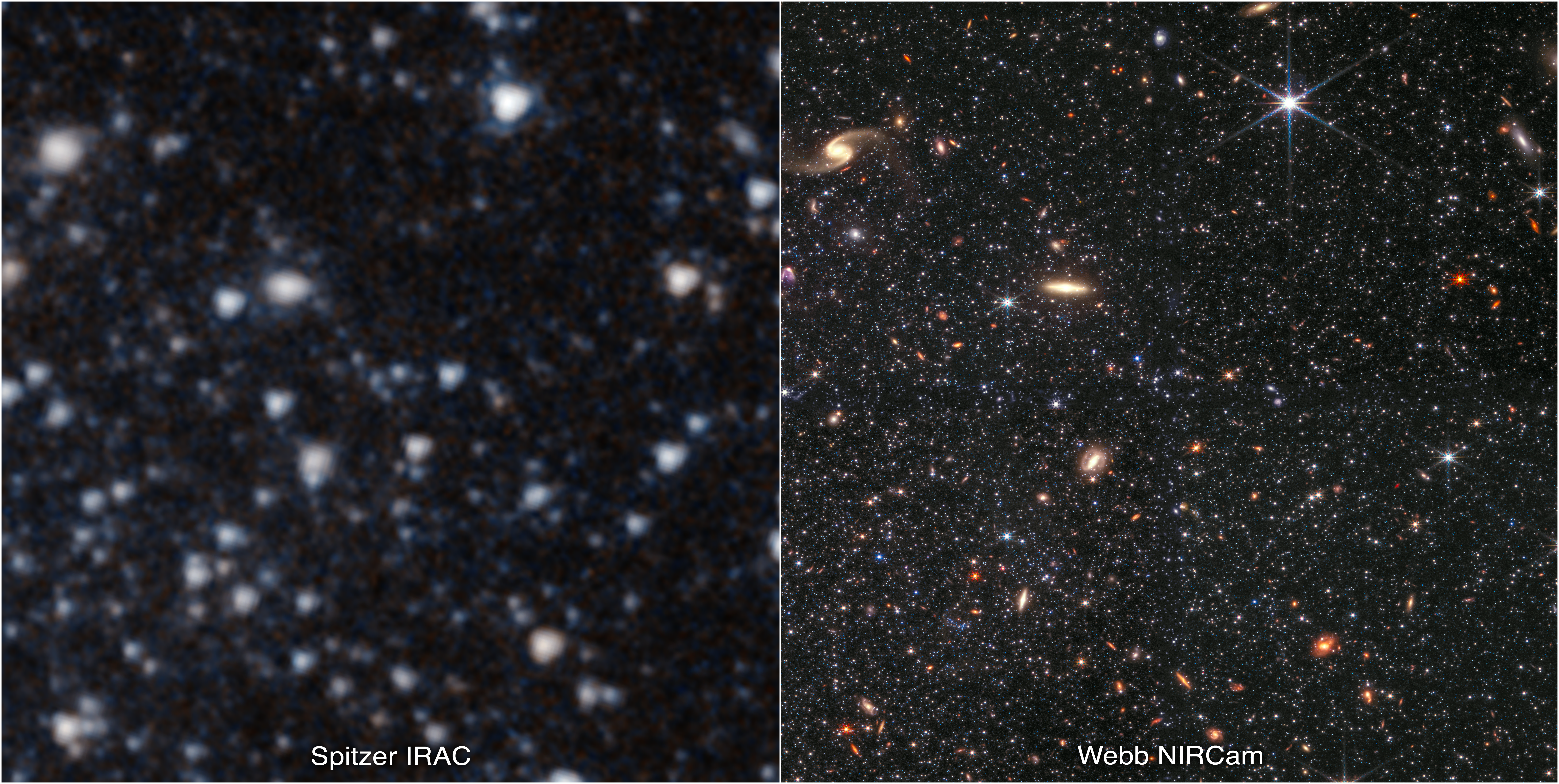1 min read
Dwarf Galaxy WLM (Spitzer IRAC and Webb NIRCam)

A portion of the dwarf galaxy Wolf–Lundmark–Melotte (WLM) captured by the Spitzer Space Telescope’s Infrared Array Camera (left) and the James Webb Space Telescope’s Near-Infrared Camera (right). The images demonstrate Webb’s remarkable ability to resolve faint stars outside the Milky Way. The Spitzer image shows 3.6-micron light in cyan and 4.5-micron in orange. (IRAC1 and IRAC2). The Webb image includes 0.9-micron light shown in blue, 1.5-micron in cyan, 2.5-micron in yellow, and 4.3-micron in red (filters F090W, F150W, F250M, and F430M).
Read the story, watch a zoom-in, or explore the Webb image on its own.
About the Object
- R.A. PositionR.A. PositionRight ascension – analogous to longitude – is one component of an object's position.00:01:57.429
- Dec. PositionDec. PositionDeclination – analogous to latitude – is one component of an object's position.-15:28:52.49
- ConstellationConstellationOne of 88 recognized regions of the celestial sphere in which the object appears.Cetus
- DistanceDistanceThe physical distance from Earth to the astronomical object. Distances within our solar system are usually measured in Astronomical Units (AU). Distances between stars are usually measured in light-years. Interstellar distances can also be measured in parsecs.About 3 million light-years away
- DimensionsDimensionsThe physical size of the object or the apparent angle it subtends on the sky.The field of each image is about 2 arcminutes across (1,700 light-years)
About the Data
- Data DescriptionData DescriptionProposal: A description of the observations, their scientific justification, and the links to the data available in the science archive.
Science Team: The astronomers who planned the observations and analyzed the data. "PI" refers to the Principal Investigator.The Webb image was created from JWST data from proposal: 1334 (D. Weisz)
- InstrumentInstrumentThe science instrument used to produce the data.Spitzer>IRAC Webb>NIRCam
- Exposure DatesExposure DatesThe date(s) that the telescope made its observations and the total exposure time.Spitzer: 5 Feb 2010 Webb: 23-24 July 2022
- FiltersFiltersThe camera filters that were used in the science observations.Spitzer: IRAC 3.6µm, IRAC 4.5µm Webb: F090W, F150W, F250M, F430M
- Object NameObject NameA name or catalog number that astronomers use to identify an astronomical object.Wolf–Lundmark–Melotte (WLM)
- Object DescriptionObject DescriptionThe type of astronomical object.Barred, irregular, dwarf galaxy
- Release DateNovember 9, 2022
- CreditNASA, ESA, CSA, Caltech/IPAC, Kristen McQuinn (Rutgers University); Image Processing: Zoltan Levay (STScI), Alyssa Pagan (STScI)

These images are a composite of separate exposures acquired by the Spitzer Space Telescope and the James Webb Space Telescope using the IRAC and NIRCam instruments respectively. Several filters were used to sample different infrared wavelength ranges. The color results from assigning different hues (colors) to each monochromatic (grayscale) image associated with an individual filter. In this case, the assigned colors are: Spitzer> Cyan: IRAC 3.6um, Orange: IRAC 4.5um Webb> Blue: F090W, Cyan: F150W, Yellow: F250M, Red: F430M
Share
Details
Laura Betz
NASA’s Goddard Space Flight Center
Greenbelt, Maryland
laura.e.betz@nasa.gov
NASA, ESA, CSA, Caltech/IPAC, Kristen McQuinn (Rutgers University)
Zoltan Levay (STScI), Alyssa Pagan (STScI)






























